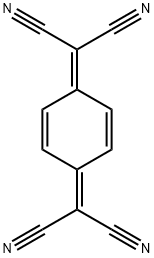
7,7,8,8-Тетрацианохинодиметан
- английское имя7,7,8,8-Tetracyanoquinodimethane
- CAS №1518-16-7
- CBNumberCB6306980
- ФормулаC12H4N4
- мольный вес204.19
- EINECS216-174-8
- номер MDLMFCD00011664
- файл Mol1518-16-7.mol
химическое свойство
| Температура плавления | 287-289 °C (dec.) (lit.) |
| Температура кипения | 332.67°C (rough estimate) |
| плотность | 1.3596 (rough estimate) |
| показатель преломления | 1.5000 (estimate) |
| температура хранения | Sealed in dry,Room Temperature |
| форма | Crystalline Powder |
| цвет | Orange-brown to green |
| Растворимость в воде | insoluble |
| Полупроводниковые характеристики | N-type (mobility=10-5cm2/V·s) |
| λмакс | 395nm(CH3CN)(lit.) |
| БРН | 611604 |
| Стабильность | Stable. Incompatible with strong acids, strong bases, strong reducing agents, strong oxidizing agents. |
| InChI | InChI=1S/C12H4N4/c13-5-11(6-14)9-1-2-10(4-3-9)12(7-15)8-16/h1-4H |
| ИнЧИКей | PCCVSPMFGIFTHU-UHFFFAOYSA-N |
| SMILES | C1(=C(C#N)C#N)C=CC(=C(C#N)C#N)C=C1 |c:8,t:0| |
| Справочник по базе данных CAS | 1518-16-7(CAS DataBase Reference) |
| FDA UNII | HC6FB4H2KW |
| Справочник по химии NIST | Propanedinitrile, 2,2'-(2,5-cyclohexadiene-1,4-diylidene)bis-(1518-16-7) |
| Система регистрации веществ EPA | Propanedinitrile, 2,2'-(2,5-cyclohexadiene-1,4-diylidene)bis- (1518-16-7) |
| UNSPSC Code | 12352103 |
| NACRES | NA.23 |
больше
| Коды опасности | Xn,Xi,T | |||||||||
| Заявления о рисках | 22-20/21/22-23/24/25 | |||||||||
| Заявления о безопасности | 22-24/25-36/37-26-36-45 | |||||||||
| РИДАДР | 3276 | |||||||||
| WGK Германия | 3 | |||||||||
| RTECS | GU4850000 | |||||||||
| Примечание об опасности | Irritant | |||||||||
| TSCA | Yes | |||||||||
| Класс опасности | 6.1 | |||||||||
| Группа упаковки | II | |||||||||
| кода HS | 29269095 | |||||||||
| NFPA 704: |
|
рисовальное письмо(GHS)
-
рисовальное письмо(GHS)

-
сигнальный язык
опасность
-
вредная бумага
H301+H311+H331:Токсично при проглатывании, при контакте с кожей или при вдыхании.
-
оператор предупредительных мер
P280:Использовать перчатки/ средства защиты глаз/ лица.
P301+P310+P330:ПРИ ПРОГЛАТЫВАНИИ: Немедленно обратиться за медицинской помощью. Прополоскать рот.
P302+P352+P312:ПРИ ПОПАДАНИИ НА КОЖУ: Промыть большим количеством воды. Обратиться за медицинской помощью при плохом самочувствии.
P304+P340+P311:ПРИ ВДЫХАНИИ: Свежий воздух, покой. Обратиться за медицинской помощью.
7,7,8,8-Тетрацианохинодиметан химические свойства, назначение, производство
Описание
7,7,8,8-tetracyanoquinodimethane (TCNQ), with a LUMO at 4.5 eV, is known for the charge-transfer salts formed by its radical anion TCNQ in?photovoltaic, light-emitting diodes, and organic field-effect transistor?devices. TCNQ and its derivatives?have been used as dopants, leading to an increase in hole mobility or to the lowering of injection?barriers. One classic example of such is the treatment of tetrathiafulvene (TTF), an electron donor with TCNQ. TFF and TCNQ form an ion pair, the TTF-TCNQ complex. This process of doping leads to the crystallisation of the ion pair into a one-dimensionally stacked polymer. This polymer consists of segregated stacks of cations and anions of the donors and the acceptors, respectively. The complex crystal is an organic semiconductor that exhibits metallic electric conductivity [1, 2].Химические свойства
orange to green crystalline powderИстория
The first report on the electrical conductivity in an organic solid appeared in 1954, namely, a perylene—bromine complex with a room-temperature conductivity of 0.1 S cm?1. In 1960, the organic acceptor Tetracyanoquinodimethane (TCNQ; 7,7,8,8-Tetracyanoquinodimethane) was synthesized, as well as a great number of its conducting charge-transfer complexes and radical ion salts. In the 1970s, the organic donor TTF led to the first organic metal TTF-TCNQ. Its room-temperature conductivity (500 S cm?1) increases with a decrease in the temperature to the value of 6000 S cm?1 at 60 K, where a metal-insulator transition occurs[1].Использование
7,7,8,8-Tetracyanoquinodimethane is an electron-acceptor molecule used to form charge-transfer superconductors. It is an effective catalyst used for the ?-chlorination of carboxylic acids using chlorosulfonic acid; the presence of TCNQ suppresses competing free-radical chlorination.Определение
ChEBI: A quinodimethane that is p-quinodimethane in which the methylidene hydrogens are replaced by cyano groups.Общее описание
7,7,8,8-Tetracyanoquinodimethane (TNCQ) is a strong electron acceptor as it has four cyano groups and π-conjugation bonds that form charge transferring chains and ion radical salts which are mainly used as p-dopants for the fabrication of a variety of semiconductor applications.7,7,8,8-Тетрацианохинодиметан запасные части и сырье
запасной предмет
7,7,8,8-Тетрацианохинодиметан поставщик
| поставщик | телефон | страна | номенклатура продукции | благоприятные условия | |
|---|---|---|---|---|---|
| +undefined+86-19307248857 | China | 982 | 58 | ||
| +86-0533-2185556 +8617865335152 |
China | 10986 | 58 | ||
| +86-75521030354 +86-18688942810 |
China | 802 | 55 | ||
| 0431-80514535 13634302652 | CHINA | 967 | 58 | ||
| +8618523575427 | China | 49732 | 58 | ||
| +86-0371-86658258 +8613203830695 |
China | 29809 | 58 | ||
| 18017061086 | CHINA | 5600 | 58 | ||
| +8618530059196 | China | 11805 | 58 | ||
| +86-025-025-85281586 +8618651653755 |
China | 1226 | 58 | ||
| +86-0551-65418671 +8618949823763 |
China | 34563 | 58 |